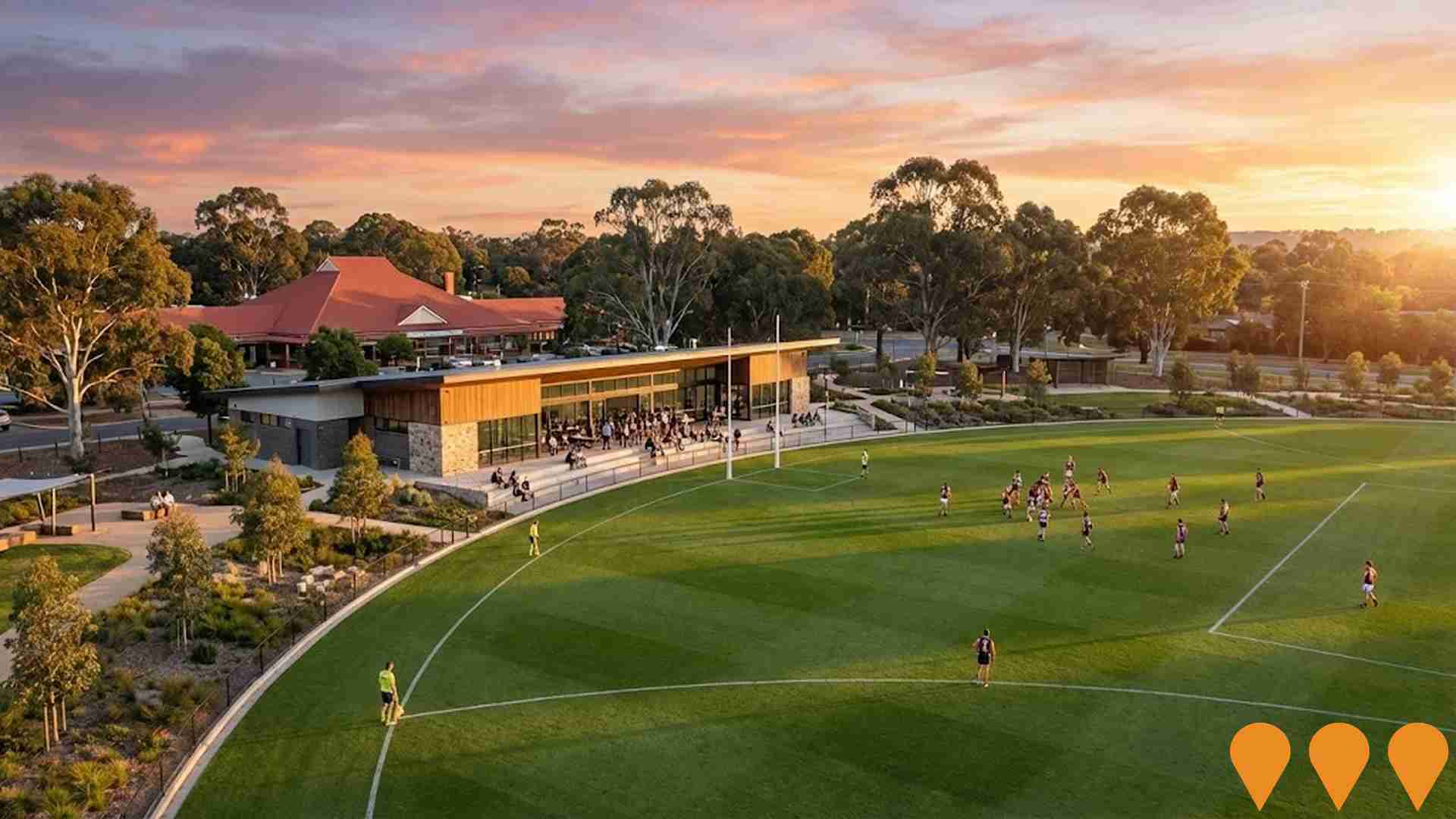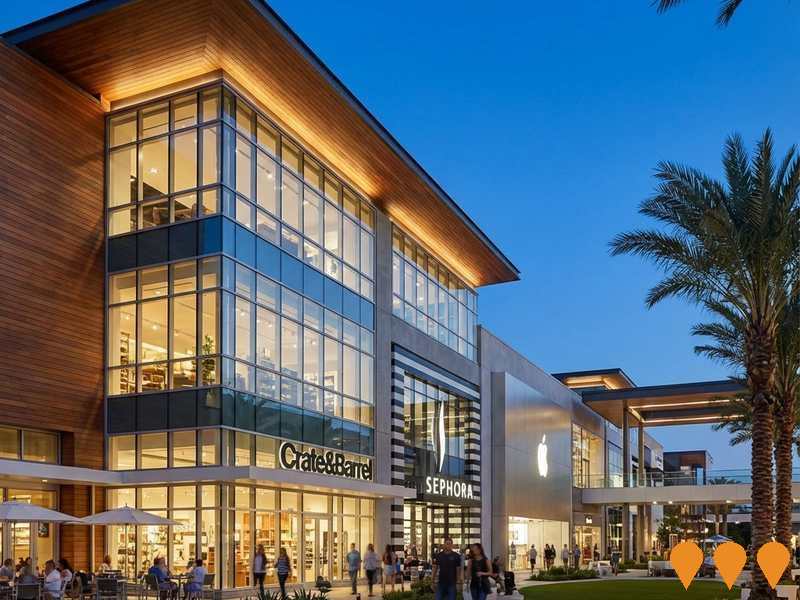Chart Color Schemes
est. as @ -- *
ABS ERP | -- people | --
2021 Census | -- people
Sales Activity
Curious about local property values? Filter the chart to assess the volume and appreciation (including resales) trends and regional comparisons, or scroll to the map below view this information at an individual property level.
Find a Recent Sale
Sales Detail
Population
An assessment of population growth drivers in Reid reveals an overall ranking slightly below national averages considering recent, and medium term trends
As of August 2025, Reid's population is approximately 1,957, reflecting a growth of 413 people since the 2021 Census. The 2021 Census reported a population of 1,544 in Reid. This increase represents a 26.7% change from the Census date, inferred from ABS estimates and address validation as of June 2024. With this population, Reid has a density ratio of 2,081 persons per square kilometer, higher than the average seen across national locations assessed by AreaSearch. Reid's growth since the 2021 census exceeded both state (5.7%) and SA4 region averages, marking it as a growth leader in the area. Interstate migration contributed approximately 62.4% of overall population gains during recent periods, with all drivers including overseas migration and natural growth being positive factors.
AreaSearch adopts ABS/Geoscience Australia projections for each SA2 area, released in 2024 with 2022 as the base year. For areas not covered by this data and years post-2032, age group growth rates from ACT Government's SA2 area projections are used, also based on 2022. Based on these projections, Reid is forecast to experience significant population increase in the top quartile of national statistical areas by 2041, with an expected increase of 668 persons and a total increase of 34.1% over the 17-year period.
Frequently Asked Questions - Population
Development
Residential development activity is lower than average in Reid according to AreaSearch's national comparison of local real estate markets
Reid has seen approximately one new home approved annually over the past five financial years, with nine homes approved between FY21-FY25 and none yet in FY26. On average, 41.4 new residents have arrived per dwelling constructed each year during this period.
This significant demand exceeding supply typically leads to price growth and increased buyer competition. The average construction cost of new properties is $1,200,000, indicating a focus on the premium market segment with higher-end properties. Compared to the Australian Capital Territory, Reid has significantly less development activity, 92.0% below the regional average per person. This constrained new construction often reinforces demand and pricing for existing properties, though recent activity has intensified. However, this activity remains under the national average, suggesting the area's established nature and potential planning limitations.
Recent development has consisted entirely of standalone homes, maintaining Reid's traditional suburban character with a focus on family homes appealing to those seeking space. New construction favours detached housing more than current patterns suggest (36.0% at Census), demonstrating ongoing robust demand for family homes despite increasing density pressures. With around 1212 people per dwelling approval, Reid reflects a highly mature market. Future projections show Reid adding 668 residents by 2041. If current development rates continue, housing supply may not keep pace with population growth, potentially increasing competition among buyers and supporting stronger price growth.
Frequently Asked Questions - Development
Infrastructure
Reid has moderate levels of nearby infrastructure activity, ranking in the top 50% nationally
Changes to local infrastructure significantly impact an area's performance. AreaSearch identified 19 projects likely affecting the region. Notable initiatives include Academy Close Redevelopment in Campbell, Australian War Memorial Redevelopment, Lonsdale & Girrahween in Braddon (Section 34), and The Foothills development in Campbell on the former CSIRO site. The following list details projects most relevant to the area.
Professional plan users can use the search below to filter and access additional projects.
INFRASTRUCTURE SEARCH
 Denotes AI-based impression for illustrative purposes only, not to be taken as definitive under any circumstances. Please follow links and conduct other investigations from the project's source for actual imagery. Developers and project owners wishing us to use original imagery please Contact Us and we will do so.
Denotes AI-based impression for illustrative purposes only, not to be taken as definitive under any circumstances. Please follow links and conduct other investigations from the project's source for actual imagery. Developers and project owners wishing us to use original imagery please Contact Us and we will do so.
Frequently Asked Questions - Infrastructure
Light Rail Extension Planning - Braddon
Planning and concept work for potential future extensions of the Canberra light rail network that would improve access for Braddon and nearby inner north precincts. The ACT Government is currently focused on delivering Stage 2A from the city to Commonwealth Park and planning Stage 2B from Commonwealth Park to Woden, while longer term network planning identifies future stages to other corridors including Belconnen and the airport. No detailed route, scope or timing has been confirmed for any Braddon specific extension, but the precinct sits within the existing Stage 1 corridor and is included in ongoing light rail network and precinct planning.
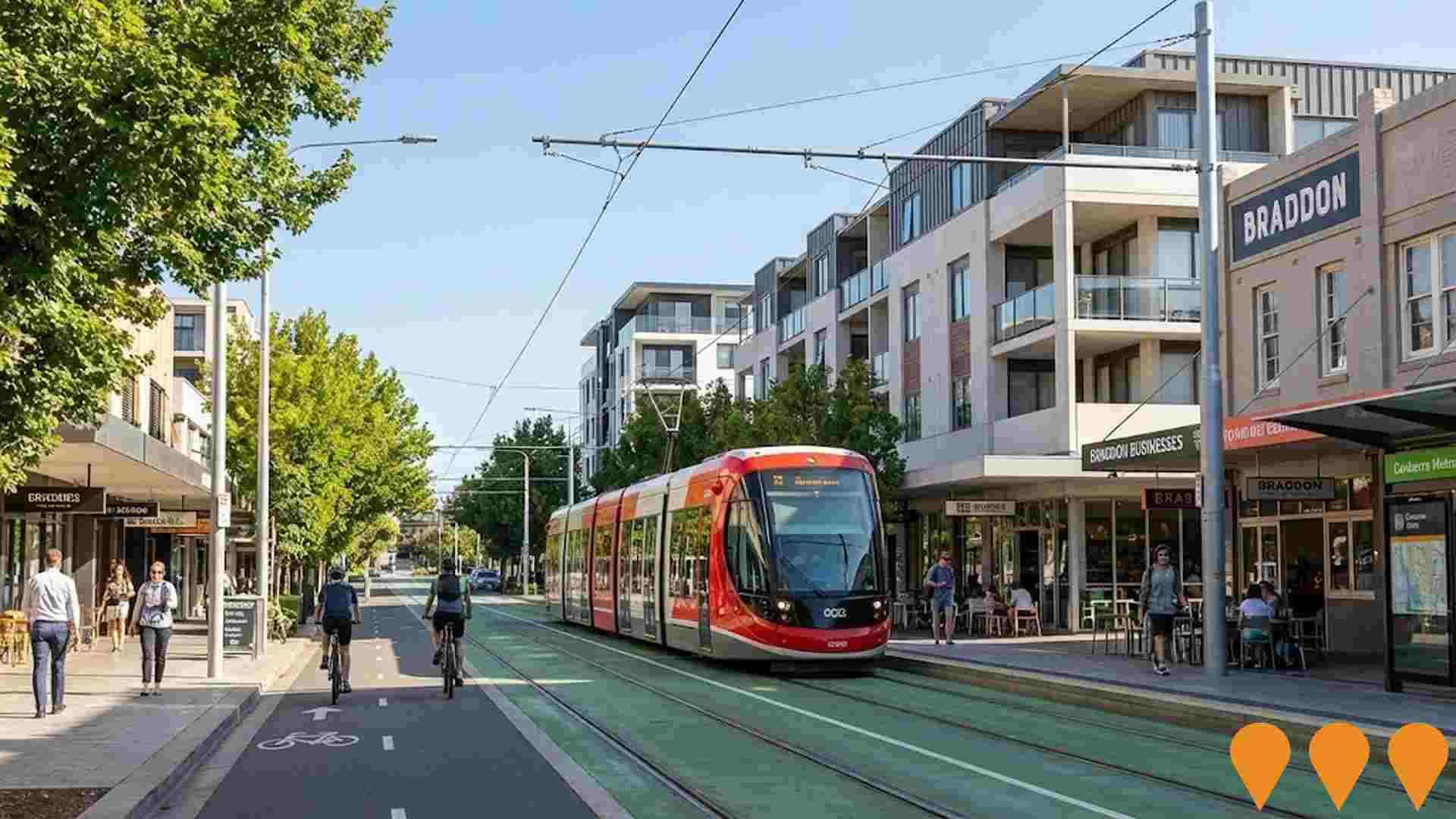
Anzac Park East
Mixed-use precinct redevelopment in Canberra's parliamentary triangle delivering a 9-storey A-grade office building (fully leased to the Australian Government) and 345 residential apartments across five towers. The project preserves and integrates heritage-listed Anzac Park East and West buildings while creating a new public realm and activated streetscape on Constitution Avenue.
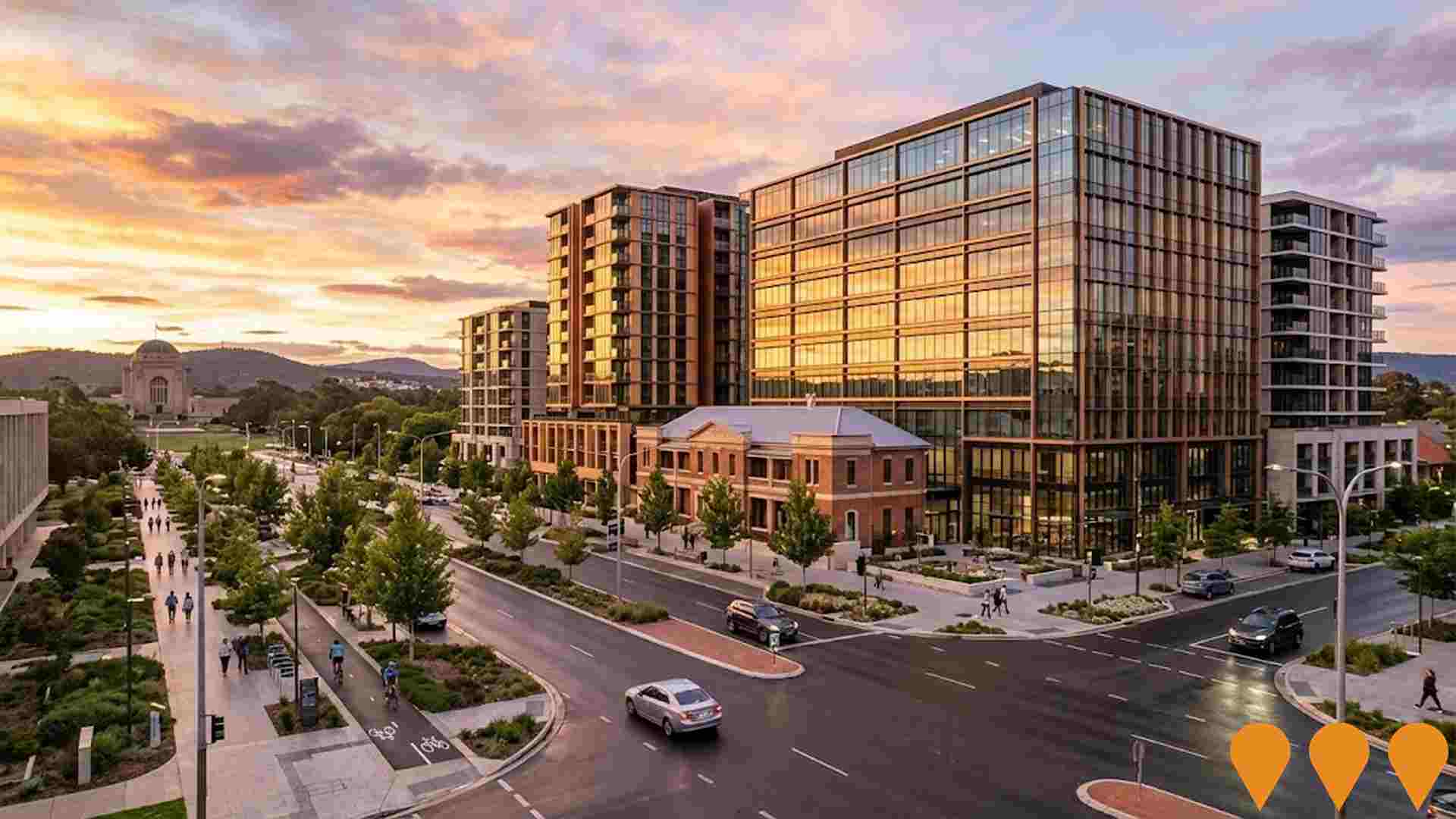
Australian War Memorial Redevelopment
The Australian War Memorial's redevelopment enlarges visitor spaces by 83%, adding 10,000 sqm for exhibitions and programs. Includes a new exhibitions area, better facilities, reflection spaces, education centers, a theatre, veterans' areas, and electronic displays.
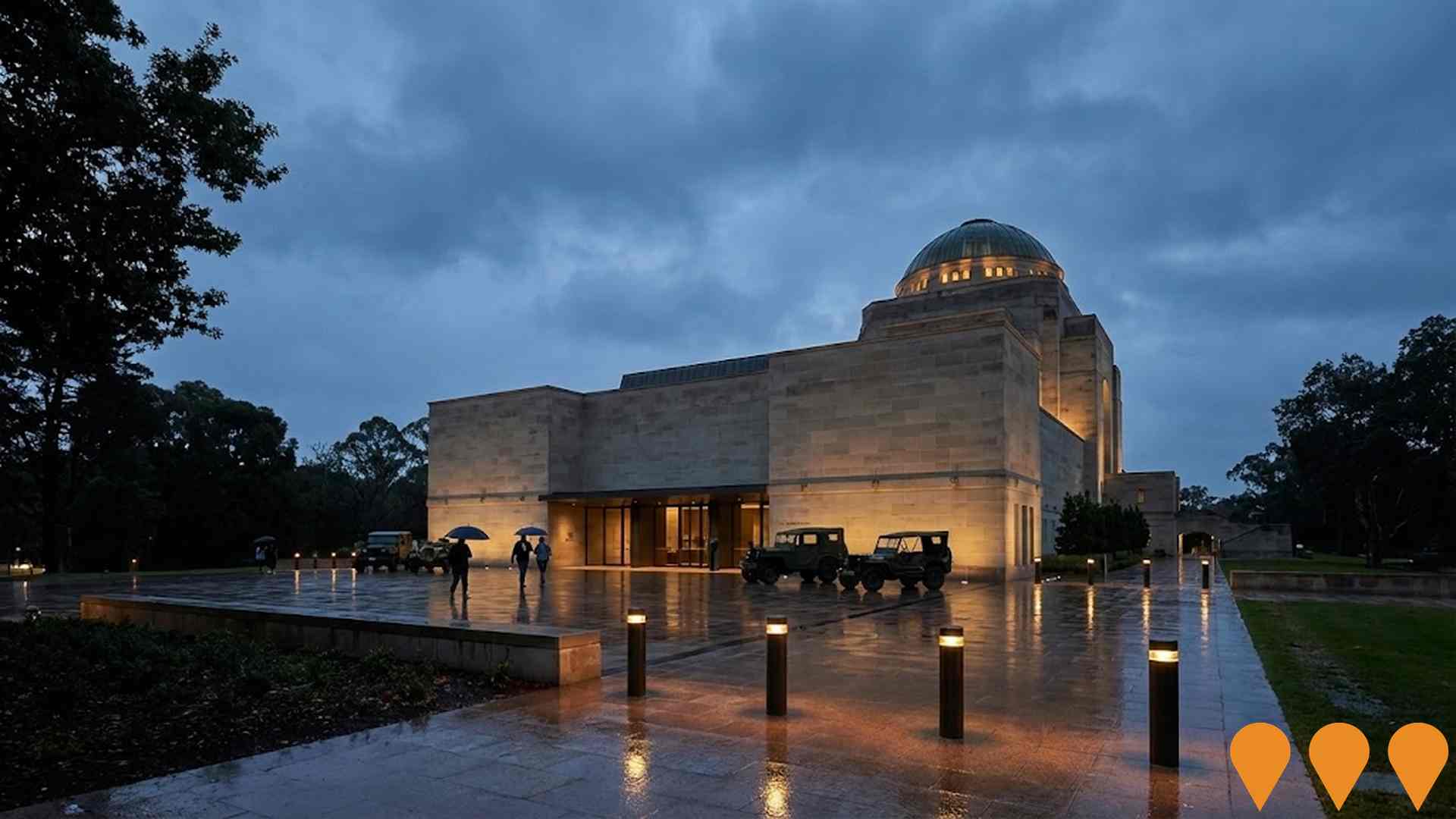
Lonsdale & Girrahween - Braddon (Section 34)
Two mixed-use towers delivering approximately 400 apartments plus retail and commercial space on the former Braddon Club site, currently under construction.

UNSW Canberra City Campus - Stage 1
The first stage of a new UNSW campus in Canberra's CBD, featuring two multi-use buildings for teaching, research, retail, and industry partners. This is part of a larger plan for a full campus with 14 buildings over five precincts.

Marcus Clarke Street Office Complex
A 12-storey premium office complex designed to accommodate growing tech and professional services companies. Features flexible floor plates, end-of-trip facilities, and sustainable building technologies.
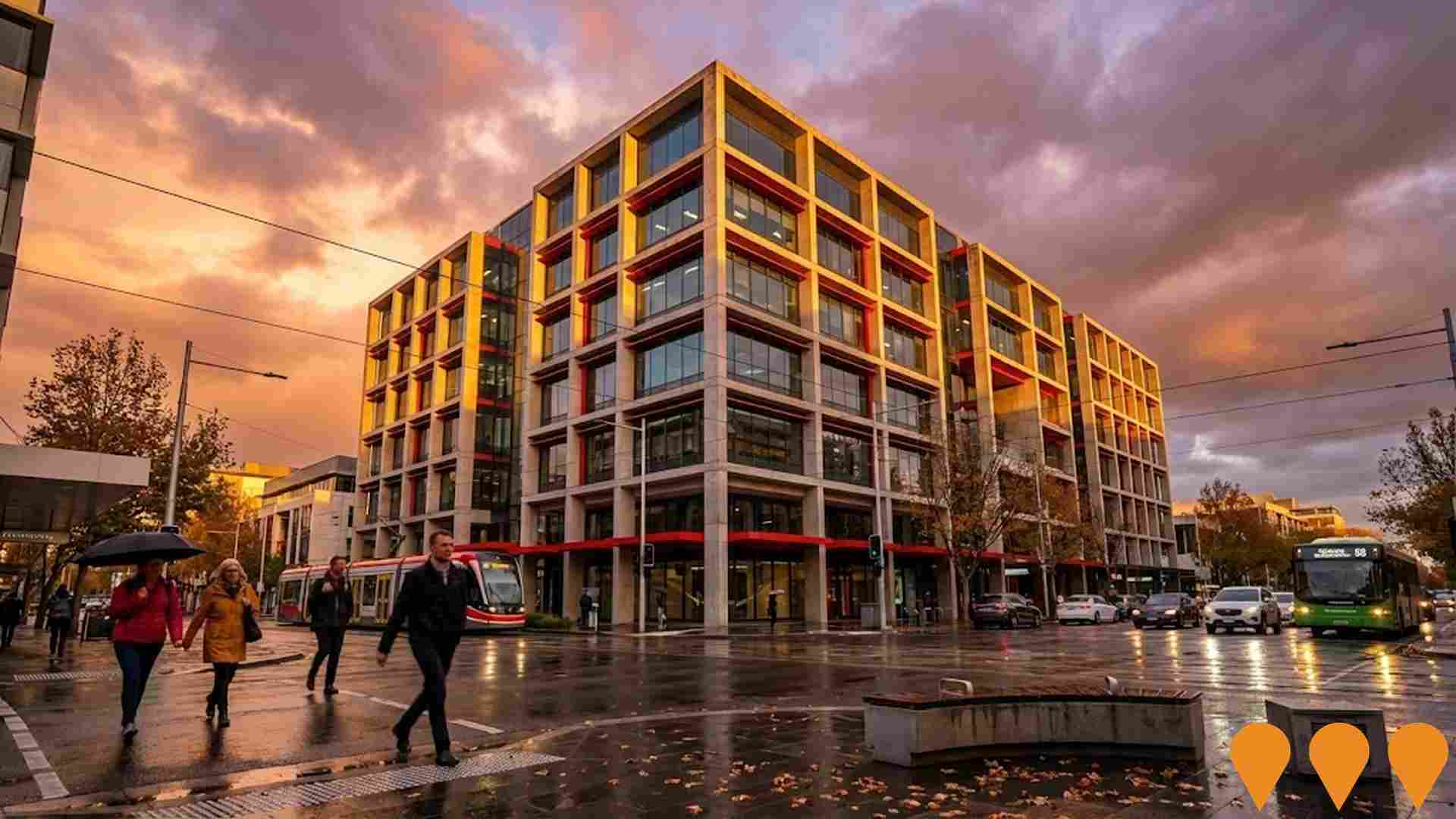
Academy Close Redevelopment - Campbell
Premium residential development by Geocon featuring 198 apartments across two towers (6 and 7 storeys) plus 28 townhouses. Located near Australian War Memorial and Russell Offices with views of Lake Burley Griffin. Includes ground floor retail, basement parking, and landscaped courtyards.

The Foothills - Campbell (Former CSIRO Site)
Mixed-use residential community on the former CSIRO headquarters site comprising two apartment buildings and townhouse precincts with resort-style shared amenities (clubhouse, pool, tennis court and landscaped parkland) across ~4 hectares. Works approvals for multiple precincts have been progressed via the NCA and sales are active via the project website.

Employment
The employment landscape in Reid shows performance that lags behind national averages across key labour market indicators
Reid has an educated workforce with strong professional services representation. The unemployment rate was 4.5% in the past year, with estimated employment growth of 2.1%.
As of June 2025, 1,159 residents were employed, with an unemployment rate of 4.6%, compared to the Australian Capital Territory's 3.4%. Workforce participation was 64.6%, below the ACT's 69.6%. Key employment sectors were public administration & safety, professional & technical, and education & training. The area had a high specialization in professional & technical services (1.4 times the regional level) but limited presence in health care & social assistance (6.9% compared to 11.7% regionally).
Many residents commuted elsewhere for work based on Census data. Between June 2024 and June 2025, employment increased by 2.1%, labour force by 1.5%, reducing unemployment by 0.6 percentage points. In comparison, ACT's employment grew by 1.9%, labour force expanded by 1.6%, and unemployment fell by 0.3 percentage points. Jobs and Skills Australia forecasts national employment growth of 6.6% over five years and 13.7% over ten years. Applying these projections to Reid's employment mix suggests local growth of approximately 6.4% over five years and 13.1% over ten years, based on a simple weighting extrapolation for illustrative purposes.
Frequently Asked Questions - Employment
Income
Income metrics indicate excellent economic conditions, with the area achieving higher performance than 75% of national locations assessed by AreaSearch
According to AreaSearch's aggregation of latest postcode level ATO data released for financial year 2022, Reid had a median income among taxpayers of $67,610 and an average level standing at $86,994. Nationally, these figures are extremely high compared to the ACT's levels of $68,678 and $83,634 respectively. Based on Wage Price Index growth of 13.6% since financial year 2022, current estimates for Reid would be approximately $76,805 (median) and $98,825 (average) as of September 2025. Census data reveals that household, family, and personal incomes in Reid rank highly nationally, between the 82nd and 95th percentiles. The distribution data shows that the largest segment comprises 31.9% earning $1,500 - 2,999 weekly (624 residents), consistent with broader trends across regional levels showing 34.3% in the same category. Reid has a substantial proportion of high earners, with 38.0% above $3,000/week, indicating strong economic capacity throughout the suburb. Housing accounts for 14.0% of income, and residents rank within the 83rd percentile for disposable income. The area's SEIFA income ranking places it in the 9th decile.
Frequently Asked Questions - Income
Housing
Reid features a more urban dwelling mix with significant apartment living, with above-average rates of outright home ownership
Reid's dwelling structure, as per the latest Census, consisted of 36.4% houses and 63.7% other dwellings (semi-detached, apartments, 'other' dwellings). In comparison, Australian Capital Territory had 39.3% houses and 60.7% other dwellings. Home ownership in Reid was at 31.2%, with mortgaged dwellings at 22.1% and rented ones at 46.7%. The median monthly mortgage repayment in Reid was $2,300, higher than the Australian Capital Territory average of $2,080. Median weekly rent in Reid was recorded at $430, compared to Australian Capital Territory's $476. Nationally, Reid's mortgage repayments were significantly higher than the Australian average of $1,863, while rents were substantially above the national figure of $375.
Frequently Asked Questions - Housing
Household Composition
Reid features high concentrations of group households and lone person households, with a lower-than-average median household size
Family households account for 47.9 percent of all households, including 15.2 percent couples with children, 27.4 percent couples without children, and 4.4 percent single parent families. Non-family households constitute the remaining 52.1 percent, with lone person households at 40.9 percent and group households comprising 10.8 percent of the total. The median household size is 2.0 people, which is smaller than the Australian Capital Territory average of 2.2.
Frequently Asked Questions - Households
Local Schools & Education
Reid performs slightly above the national average for education, showing competitive qualification levels and steady academic outcomes
Reid's educational attainment exceeds broader standards significantly: 61.5% of residents aged fifteen plus hold university qualifications compared to Australia's 30.4% and the SA4 region's 46.8%. This notable advantage positions Reid favourably for knowledge-based prospects. Bachelor degrees are most prevalent at 31.5%, followed by postgraduate qualifications (23.1%) and graduate diplomas (6.9%). Vocational pathways account for 16.0% of qualifications among those aged fifteen plus – advanced diplomas (8.5%) and certificates (7.5%).
Educational participation is notably high, with 30.6% of residents currently enrolled in formal education: 15.0% in tertiary education, 4.2% in primary education, and 4.0% pursuing secondary education.
Frequently Asked Questions - Education
Schools Detail
Nearby Services & Amenities
Transport
Transport servicing is high compared to other areas nationally based on assessment of service frequency, route connectivity and accessibility
Reid has 15 active public transport stops. These stops offer a variety of bus services. There are 12 different routes operating in total, which together facilitate 1,573 weekly passenger trips.
Reid's residents enjoy excellent transport accessibility, with an average distance of 168 meters to the nearest stop. The service frequency is quite high, with an average of 224 trips per day across all routes, translating to about 104 weekly trips per individual stop.
Frequently Asked Questions - Transport
Transport Stops Detail
Health
Reid's residents are healthier than average in comparison to broader Australia with a fairly standard level of common health conditions seen across both young and old age cohorts
Reid's health data shows positive outcomes for its residents, with common health conditions being quite standard across both younger and older age groups. Approximately 64% of Reid's total population (1,248 people) has private health cover, which is higher than the national average of 55.3%.
Mental health issues and arthritis are the most prevalent medical conditions in the area, affecting 11.6% and 8.1% of residents respectively. A total of 65.7% of Reid's residents report no medical ailments, compared to 70.8% across Australian Capital Territory. As of 2021, 16.5% of Reid's population is aged 65 and over (322 people), which is higher than the 11.4% in Australian Capital Territory. Despite this, health outcomes among seniors in Reid are particularly strong, performing better than the general population in various health metrics.
Frequently Asked Questions - Health
Cultural Diversity
Reid was found to be more culturally diverse than the vast majority of local markets in Australia, upon assessment of a range of language and cultural background related metrics
Reid's population was found to be more linguistically diverse than most local markets, with 20.2% speaking a language other than English at home as of 2016 Census data. This diversity is further reflected in the birthplace of residents, with 31.7% born overseas. Christianity is the predominant religion in Reid, making up 36.7% of its population.
However, Judaism is notably overrepresented in Reid compared to the Australian Capital Territory, comprising 0.6% versus 0.5%. In terms of ancestry (country of birth of parents), the top three groups in Reid are English at 25.4%, Australian at 20.6%, and Other at 11.5%. Some ethnic groups show notable divergences: Polish is overrepresented at 1.3% versus 0.9% regionally, French at 1.0% versus 0.7%, and Hungarian at 0.5% versus 0.3%.
Frequently Asked Questions - Diversity
Age
Reid's population is slightly older than the national pattern
Reid has a median age of 39, which is older than the Australian Capital Territory's figure of 35 and comparable to Australia's median age of 38. The 25-34 age group makes up 23.0% of Reid's population, higher than the Australian Capital Territory's percentage but lower than the national average of 14.5%. The 5-14 age group is less prevalent in Reid at 4.9%. Between 2021 and the present, Reid's median age has decreased by 1.3 years from 40 to 39, indicating a shift towards a younger demographic. During this period, the 25-34 age group grew from 19.8% to 23.0%, while the 55-64 cohort declined from 14.9% to 13.2% and the 65-74 group dropped from 11.5% to 10.1%. By 2041, demographic modeling suggests Reid's age profile will evolve significantly. The 65-74 age group is projected to grow by 56%, reaching 307 people from its current figure of 196.
